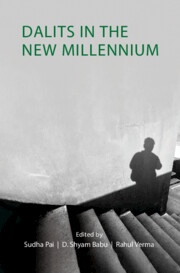Book contents
- Frontmatter
- Contents
- List of Figures
- List of Tables
- Acknowledgements
- 1 Introduction: Dalit Discourse in the New Millennium
- Part I Shifting Patterns of Electoral Politics
- Part II Popular Culture, Discourse, and Protest
- Part III Transformations in Ideology and Identity
- 11 Annihilation, Identity, Representation: Kanshi Ram and the Conundrums of Dalit Political Agency
- 12 Reading Caste and Class Together: A Dalit–Bahujan–Left Alliance?
- 13 Towards Radical Democracy: The Dalit–Bahujan Claim for Political Power
- 14 Liberation Panthers and the Dalit Challenge to Hindutva in Tamil Nadu
- 15 Dalit–Bahujan Politics: Crisis and Future
- Part IV Aspirations and Anxieties
- Part V Discrimination and Representation
- About the Contributors
- Index
13 - Towards Radical Democracy: The Dalit–Bahujan Claim for Political Power
from Part III - Transformations in Ideology and Identity
Published online by Cambridge University Press: 12 July 2023
- Frontmatter
- Contents
- List of Figures
- List of Tables
- Acknowledgements
- 1 Introduction: Dalit Discourse in the New Millennium
- Part I Shifting Patterns of Electoral Politics
- Part II Popular Culture, Discourse, and Protest
- Part III Transformations in Ideology and Identity
- 11 Annihilation, Identity, Representation: Kanshi Ram and the Conundrums of Dalit Political Agency
- 12 Reading Caste and Class Together: A Dalit–Bahujan–Left Alliance?
- 13 Towards Radical Democracy: The Dalit–Bahujan Claim for Political Power
- 14 Liberation Panthers and the Dalit Challenge to Hindutva in Tamil Nadu
- 15 Dalit–Bahujan Politics: Crisis and Future
- Part IV Aspirations and Anxieties
- Part V Discrimination and Representation
- About the Contributors
- Index
Summary
We do not want a little place in the brahmin alley. We want to rule the whole country. We are not looking at persons but at a system. Change of heart, liberal education, etc. will not end our state of exploitation. When we gather a revolutionary mass, rouse the people, out of the struggle of this giant mass will come the tidal wave of revolutions.
—Dalit Panthers’ Manifesto (1973)Liberal Democracy and Dalits
Democracy's relationship with marginalized communities is often seen as a benevolent gesture of modernity, by which the disadvantaged communities that were hovering outside the purview of power can now be accommodated and represented in the new regime (Phillips, 1990). The modern nation builders of India acknowledged that the historically marginalized communities must have proportionate representation in the new institutions of power, and, reasonably, the erstwhile untouchables and Adivasis are identified as the new shareholders, bargainers, or participants in the nation-making process. It was recognized that accommodation and representation of the lower strata in mainstream civil and political life is crucial for India's nascent democracy. Heralding the objectives of social justice, the state became the prime force for empowerment and emancipation of marginalized communities, especially the ex-untouchable castes. Through various laws and policy mechanisms (like the reservation policy for the Scheduled Castes [SCs] and Scheduled Tribes [STs]), it was assumed that the empowerment of Dalits would soon be achieved.
In post-independence India, these communities welcomed the new constitutional state with the hope that due to their significant numbers, they may have a substantive share in power and would thus influence or determine the nature of state functioning. In this chapter, I have argued that though the politics of social justice has remained one of the major tools to imagine an empowered position for Dalits in the modern state, it is their quest to become the political ruling class that has radically emancipated them from their depressed social location. In the normal social science discourse, the Dalit movement is highlighted as a dynamic force that aspired to democratize modern institutions by ensuring sizeable participation of socially marginalized groups.
- Type
- Chapter
- Information
- Dalits in the New Millennium , pp. 232 - 246Publisher: Cambridge University PressPrint publication year: 2023

